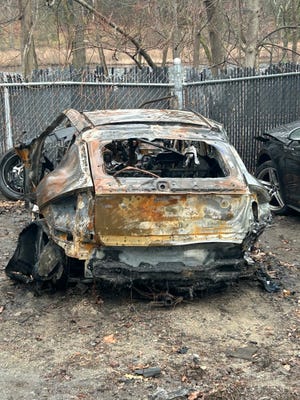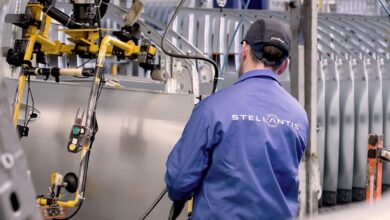EV fires bring added challenges for MA firefighters

WAYLAND — When the Wayland Fire and Police departments responded early on the morning of March 30 to what turned out to be a fatal crash on Shaw Drive, firefighters encountered problems while trying to douse the flames of the burning SUV.
That’s because the car, a Kia EV6, was not traditionally gas-powered; rather, it was an electric vehicle.
It took 40 minutes for firefighters to extinguish the fire before they could remove the victim from the SUV’s burned-out husk.
“It’s (electrical vehicle fires) one of the biggest challenges in fire services today,” said Wayland Fire Chief Neil McPherson. “These fires are harder to fight. They require greater resources. Traditional car fires, you go and you’re able to knock it down relatively quickly. These are very challenging.”
‘Truly tragic’:British Swim School owner identified as Wayland crash victim
McPherson said complicating factors include the added heat and intensity of electrical fires, as well as the location of the battery packs, usually under the vehicle’s passenger area.
Jake Wark, spokesman for the Department of Fire Services, said the agency hosted a symposium last year about dealing with the lithium-ion batteries used in electric vehicles.
Electric vehicle fires ‘can burn violently for hours’
“Electric vehicle fires pose significant challenges to firefighters,” Wark said. “Unlike gasoline-fueled vehicles, a fire in an electric vehicle can burn violently for hours, requiring many thousands of gallons of water to extinguish. And even when extinguished, they can potentially reignite. Fortunately, they’re relatively rare — but they could very well become more common as more EVs hit the road.”
Water supply was the problem during a November 2022 incident in Sherborn, as firefighters there fought a hybrid-car fire on Harrington Road, Sherborn Fire Chief Zach Ward said. There were no hydrants in the area, so Sherborn had to call in mutual aid from surrounding communities to bring in tanker trucks to help extinguish the fire.
“We operated (sprayed water) on the car for four hours,” said Ward. “It smoked for weeks after.”
Building condemned:Five-alarm fire destroys Wayland strip mall
The fire, Ward said, has inspired the department to get specific equipment to help with electric vehicle and hybrid car fires, including a special blanket to help suppress fires, and a specialized nozzle that is 10 feet long and can extend underneath vehicles, where electric batteries are. The department is seeking funding during annual Town Meeting, which starts April 23.
One piece of comforting news: According to a survey by the National Transportation Safety Board, as of June 2023, electric vehicles were far less likely to catch fire than other vehicle types. The agency determined that only 25.1 electric vehicles out of every 100,000 sold were found to have caught fire, compared to 1,529.9 gas-powered vehicles and 3,474.5 hybrid vehicles.
WPI professor describes process of ‘thermal runaway’ in electric car fires
Milosh Puchovsky, a professor of fire protection engineering at Worcester Polytechnic Institute, said another big issue with electric car fires is what’s called “thermal runaway.” He said electric vehicle batteries are comprised of numerous cells. When a cell heats up, it begins to build gas. And that gas, if a cell container is burst during a crash, can cause fire.
Puchovsky said such bursting activity can spread from cell to cell, reigniting as it spreads.

“That combustion can be very rapid, and it can be in the form of an explosion,” he said. “You can have a pressure wave you’re dealing with. You may even have projectiles you’re dealing with.”
The goal for firefighters is twofold: getting the fire extinguished as quickly as possible and cooling down the vehicle before thermal runaway begins, Puchovsky said. But once the process of thermal runaway starts, it’s almost impossible to stop.
He said there are various methods and tools, such as the two that Sherborn hopes to buy, as well as using a crane or forklift to put the car into a giant dumpster and submerge it in water.
“They do present a lot of problems for us in the fire prevention community,” Puchovsky said. “There are a lot of programs being put in place to study this kind of thing.”

In last month’s Wayland crash, it took 40 minutes to remove the victim’s body from the car. McPherson said he’s especially concerned about what can happen if firefighters need to respond to a similar incident with someone trapped alive in a vehicle.
“We need to be able to operate in a safe environment if we have to extricate someone,” McPherson said. “It takes longer to put out (an electric car fire), and there’s a greater chance that person won’t be able to survive. Obviously, we’d love to jump right in there to get the person, but we can’t.”
Norman Miller can be reached at 508-626-3823 or nmiller@wickedlocal.com. For up-to-date public safety news, follow him on X @Norman_MillerMW or on Facebook at facebook.com/NormanMillerCrime.



